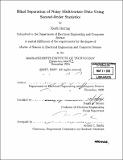| dc.contributor.advisor | David H. Staelin. | en_US |
| dc.contributor.author | Herring, Keith, 1981- | en_US |
| dc.contributor.other | Massachusetts Institute of Technology. Dept. of Electrical Engineering and Computer Science. | en_US |
| dc.date.accessioned | 2006-03-24T18:26:23Z | |
| dc.date.available | 2006-03-24T18:26:23Z | |
| dc.date.copyright | 2005 | en_US |
| dc.date.issued | 2005 | en_US |
| dc.identifier.uri | http://hdl.handle.net/1721.1/30173 | |
| dc.description | Thesis (S.M.)--Massachusetts Institute of Technology, Dept. of Electrical Engineering and Computer Science, 2005. | en_US |
| dc.description | Includes bibliographical references (leaves 81-83). | en_US |
| dc.description.abstract | A second-order method for blind source separation of noisy instantaneous linear mixtures is presented and analyzed for the case where the signal order k and noise covariance GG-H are unknown. Only a data set X of dimension n > k and of sample size m is observed, where X = AP + GW. The quality of separation depends on source-observation ratio k/n, the degree of spectral diversity, and the second-order non-stationarity of the underlying sources. The algorithm estimates the Second-Order separation transform A, the signal Order, and Noise, and is therefore referred to as SOON. SOON iteratively estimates: 1) k using a scree metric, and 2) the values of AP, G, and W using the Expectation-Maximization (EM) algorithm, where W is white noise and G is diagonal. The final step estimates A and the set of k underlying sources P using a variant of the joint diagonalization method, where P has k independent unit-variance elements. Tests using simulated Auto Regressive (AR) gaussian data show that SOON improves the quality of source separation in comparison to the standard second-order separation algorithms, i.e., Second-Order Blind Identification (SOBI) [3] and Second-Order Non-Stationary (SONS) blind identification [4]. The sensitivity in performance of SONS and SOON to several algorithmic parameters is also displayed in these experiments. To reduce sensitivities in the pre-whitening step of these algorithms, a heuristic is proposed by this thesis for whitening the data set; it is shown to improve separation performance. Additionally the application of blind source separation techniques to remote sensing data is discussed. | en_US |
| dc.description.abstract | (cont.) Analysis of remote sensing data collected by the AVIRIS multichannel visible/infrared imaging instrument shows that SOON reveals physically significant dynamics within the data not found by the traditional methods of Principal Component Analysis (PCA) and Noise Adjusted Principal Component Analysis (NAPCA). | en_US |
| dc.description.statementofresponsibility | by Keith Herring. | en_US |
| dc.format.extent | 83 leaves | en_US |
| dc.format.extent | 3818073 bytes | |
| dc.format.extent | 3827111 bytes | |
| dc.format.mimetype | application/pdf | |
| dc.format.mimetype | application/pdf | |
| dc.language.iso | eng | en_US |
| dc.publisher | Massachusetts Institute of Technology | en_US |
| dc.rights | M.I.T. theses are protected by copyright. They may be viewed from this source for any purpose, but reproduction or distribution in any format is prohibited without written permission. See provided URL for inquiries about permission. | en_US |
| dc.rights.uri | http://dspace.mit.edu/handle/1721.1/7582 | |
| dc.subject | Electrical Engineering and Computer Science. | en_US |
| dc.title | Blind separation of noisy multivariate data using second-order statistics | en_US |
| dc.type | Thesis | en_US |
| dc.description.degree | S.M. | en_US |
| dc.contributor.department | Massachusetts Institute of Technology. Department of Electrical Engineering and Computer Science | |
| dc.identifier.oclc | 60678509 | en_US |
